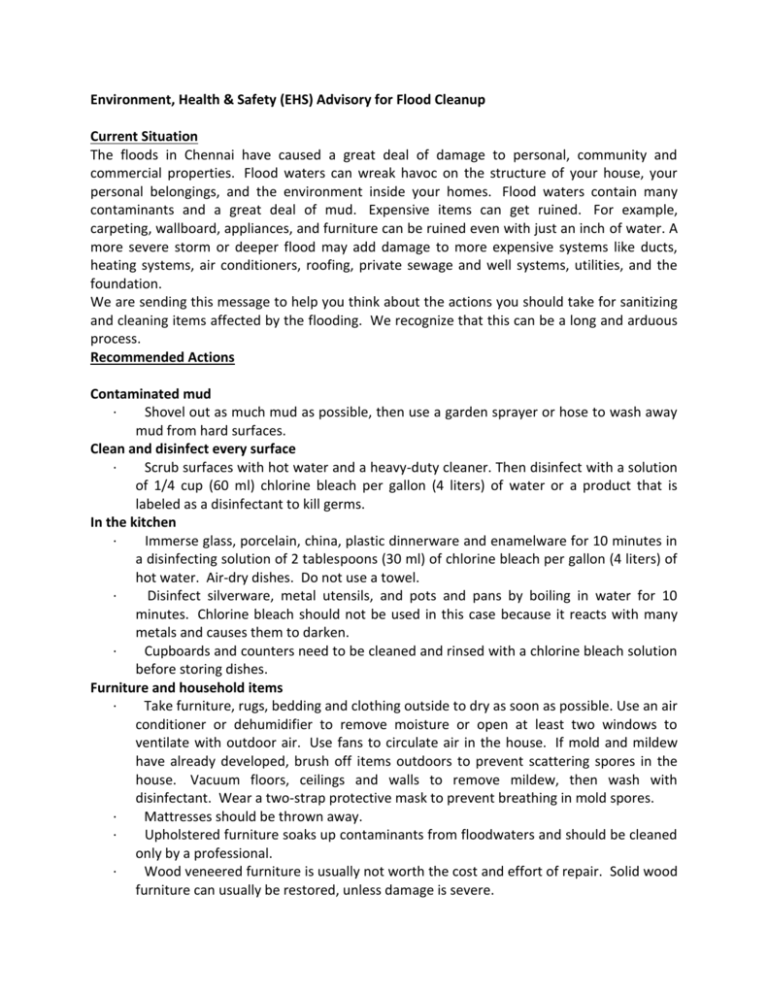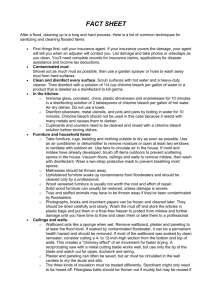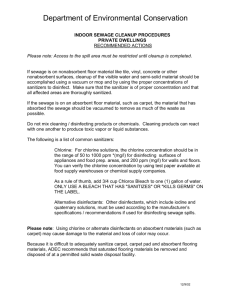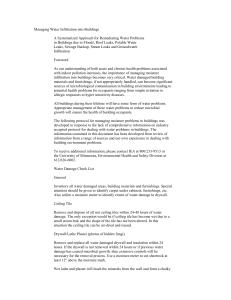Environment, Health & Safety (EHS) Advisory for Flood Cleanup
advertisement

Environment, Health & Safety (EHS) Advisory for Flood Cleanup Current Situation The floods in Chennai have caused a great deal of damage to personal, community and commercial properties. Flood waters can wreak havoc on the structure of your house, your personal belongings, and the environment inside your homes. Flood waters contain many contaminants and a great deal of mud. Expensive items can get ruined. For example, carpeting, wallboard, appliances, and furniture can be ruined even with just an inch of water. A more severe storm or deeper flood may add damage to more expensive systems like ducts, heating systems, air conditioners, roofing, private sewage and well systems, utilities, and the foundation. We are sending this message to help you think about the actions you should take for sanitizing and cleaning items affected by the flooding. We recognize that this can be a long and arduous process. Recommended Actions Contaminated mud · Shovel out as much mud as possible, then use a garden sprayer or hose to wash away mud from hard surfaces. Clean and disinfect every surface · Scrub surfaces with hot water and a heavy-duty cleaner. Then disinfect with a solution of 1/4 cup (60 ml) chlorine bleach per gallon (4 liters) of water or a product that is labeled as a disinfectant to kill germs. In the kitchen · Immerse glass, porcelain, china, plastic dinnerware and enamelware for 10 minutes in a disinfecting solution of 2 tablespoons (30 ml) of chlorine bleach per gallon (4 liters) of hot water. Air-dry dishes. Do not use a towel. · Disinfect silverware, metal utensils, and pots and pans by boiling in water for 10 minutes. Chlorine bleach should not be used in this case because it reacts with many metals and causes them to darken. · Cupboards and counters need to be cleaned and rinsed with a chlorine bleach solution before storing dishes. Furniture and household items · Take furniture, rugs, bedding and clothing outside to dry as soon as possible. Use an air conditioner or dehumidifier to remove moisture or open at least two windows to ventilate with outdoor air. Use fans to circulate air in the house. If mold and mildew have already developed, brush off items outdoors to prevent scattering spores in the house. Vacuum floors, ceilings and walls to remove mildew, then wash with disinfectant. Wear a two-strap protective mask to prevent breathing in mold spores. · Mattresses should be thrown away. · Upholstered furniture soaks up contaminants from floodwaters and should be cleaned only by a professional. · Wood veneered furniture is usually not worth the cost and effort of repair. Solid wood furniture can usually be restored, unless damage is severe. · Toys and stuffed animals may have to be thrown away if they've been contaminated by floodwaters. · Photographs, books and important papers can be frozen and cleaned later. They should be dried carefully and slowly. Wash the mud off and store the articles in plastic bags and put them in a frost-free freezer to protect from mildew and further damage until you have time to thaw and clean them or take them to a professional. Ceilings and walls · Wallboard acts like a sponge when wet. Remove wallboard, plaster and paneling to at least the flood level. If soaked by contaminated floodwater, it can be a permanent health hazard and should be removed. If most of the wallboard was soaked by clean rainwater, consider cutting a 4- to 12-inch (10-30 cm)-high section from the bottom and top of walls. This creates a "chimney effect" of air movement for faster drying. · Plaster and paneling can often be saved, but air must be circulated in the wall cavities to dry the studs and sills. · The three kinds of insulation must be treated differently. Styrofoam might only need to be hosed off. Fiberglass batts should be thrown out if muddy but may be reused if dried thoroughly. Loose or blown-in cellulose should be replaced since it holds water for a long time and can lose its antifungal and fire retardant abilities. Electrical system · The system must be shut off and repaired and inspected by an electrician before it can be turned back on. Wiring must be completely dried out- even behind walls. Switches, convenience outlets, light outlets, entrance panel, and junction boxes that have been under water may be filled with mud. Heating and cooling systems and ducts · Will need inspection and cleaning. Flood-soaked insulation should be replaced. Appliances · Appliances will get stains, odors, silt deposits, and gritty deposits and need to be serviced, cleaned and sanitized. Running equipment before it is properly cleaned could seriously damage it and/or shock you. Professional cleaning is recommended for electronics, TVs and radios, washing machines, dryers, dishwashers, and vacuum cleaners. The hard exterior can be hand cleaned. All metallic appliances that have been flooded should be properly grounded to prevent electric shock. Mud or dirt in a grounded outlet or adapter may prevent the grounding system from working, and you could be electrocuted. Pump out the basement · If your basement is full or nearly full of water, pump out just 2 or 3 feet (~ 1 meter) of water each day. If you drain the basement too quickly, the pressure outside the walls will be greater than the pressure inside the walls. That may make the walls and floor crack and collapse. Floors · With wood subflooring, the floor covering (vinyl, linoleum, carpet) must be removed so the subflooring can dry thoroughly. This may take several months. Open windows and doors to expose the boards to as much air as possible. Carpeting · Clean and dry carpets and rugs as quickly as possible. If sewage-contaminated floodwater covered your carpeting or it was under water for 24 hours or more, discard it for health and safety reasons. · To clean, drape carpets and rugs outdoors and hose them down. Work a disinfecting carpet cleaner into soiled spots with a broom. To discourage mildew and odors, rinse with a solution of 2 tablespoons (30 ml) bleach to 1 gallon (4 liters) water, but don't use this solution on wool or nylon carpets. Dry the carpet and floor thoroughly before replacing the carpet. · Padding is nearly impossible to clean, so it should be replaced. · If the carpet can't be removed, dry it as quickly as possible using a wet/dry vacuum and dehumidifier. Use a fan to circulate air above the carpet, and if possible, lift the carpet and ventilate with fans underneath. Vinyl flooring and floor tile may need to be removed to allow drying of the subfloor. Wood floors · Wooden floors should be dried gradually. Sudden drying could cause cracking or splitting. Some restoration companies can accelerate drying time by forcing air through the fluted underside of hardwood floorboards. · Remove hardwood floor boards to prevent buckling. Remove a board every few feet/meters to reduce buckling caused by swelling. Clean and dry wood before attempting repairs. Roof damage and leaks Clogged downspouts or eaves · Check for choked downspouts and any accumulated water on the roof. Cracks and deterioration · Roofing (especially wood or composition shingles) usually deteriorates first on southern exposures. Check southern slopes for cracking or deterioration. Holes · Missing shingles or holes in the roofing may be causing wet spots. To find holes, check for a drip trail or spot of light coming through in the attic. Stick a nail, straw or wire through the hole to mark the spot on the outside. Private sewage systems · Flooding of a private sewage system can be a hazardous situation for homeowners. It may lead to a back-up of sewage in the home, contaminated drinking water and a lack of sanitation until the system is fixed. When flooding or saturated soil conditions persist, a private sewage system cannot function properly. Soil treatment systems for wastewater rely on aerobic (with oxygen) regions to reduce the amounts of chemicals and living organisms (viruses, bacteria and protozoa). When the soil is saturated or flooded, those hazardous materials can enter the groundwater and your drinking water supply. (Courtesy – HP Enterprise)







